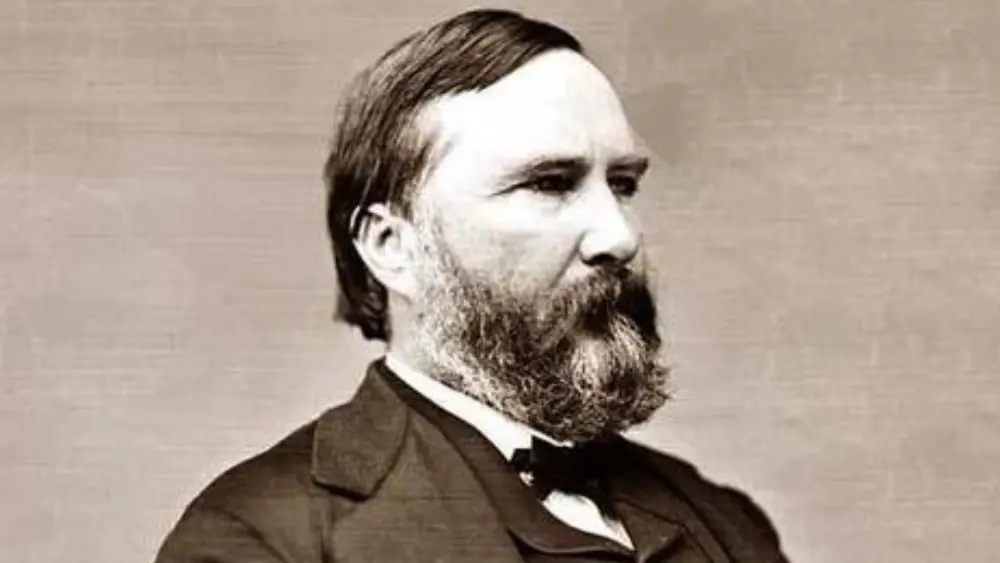James Longstreet, born on January 8, 1821, in Edgefield District, South Carolina, was a prominent Confederate general during the American Civil War. Known for his tactical brilliance and steadfast service to the Southern cause, Longstreet earned the nickname the “Old War Horse” of the Confederacy.
Early Life and Military Education
James Longstreet’s early life deeply rooted him in the American South, where he grew up amidst the rich cultural and historical landscape of the region. This upbringing instilled in him a strong sense of identity and loyalty to his homeland, values that would play a significant role in shaping his future military career. Longstreet’s path toward becoming a distinguished military officer began when he enrolled at the United States Military Academy at West Point. Graduating in 1842, he emerged from West Point with a comprehensive military education that provided him with the knowledge and skills necessary for a successful career as a soldier.
The years spent at West Point marked a transformative period in Longstreet’s life, equipping him with the foundational principles of leadership, discipline, and strategy that would define his subsequent military service. These formative experiences not only cultivated his commitment to duty but also set the stage for his future roles and responsibilities in the tumultuous years that lay ahead, most notably during the American Civil War.
Mexican-American War and Interwar Period
James Longstreet’s military journey saw its first significant chapter unfold during the Mexican-American War (1846-1848). As a young officer, Longstreet served with distinction in this conflict, gaining valuable combat experience and quickly ascending the ranks. His exemplary performance in the crucible of battle foreshadowed his future prominence as a military leader.
Following the Mexican-American War, Longstreet continued to cultivate his military career during the interwar period, taking on various assignments that broadened his expertise and showcased his versatility as an officer. His postings included service in the southwestern regions of Texas and New Mexico, where he further honed his skills and deepened his understanding of the military’s role in shaping the nation’s destiny. These formative experiences set the stage for Longstreet’s pivotal role in the looming American Civil War, where his leadership and combat prowess would leave an indelible mark on the course of history.
American Civil War
When the Civil War erupted in 1861, James Longstreet found himself faced with a momentous decision: to side with his home state of Georgia and the Confederacy or remain loyal to the United States. Opting to follow his allegiance to his state, he embarked on a path that would see him rise to prominence as a military leader. His decision proved pivotal, as Longstreet quickly earned recognition for his exceptional military acumen and leadership qualities. Throughout the conflict, he played a vital role in shaping the course of the war and leaving an indelible mark on its history.
James Longstreet’s contributions to the Confederate cause were significant and multifaceted. He demonstrated his tactical prowess and bravery in key engagements such as the First Battle of Bull Run, where he led troops with skill and determination. Longstreet’s strategic acumen came to the fore during the Peninsula Campaign, where he played a crucial role in General Robert E. Lee’s efforts to defend Virginia. He played an instrumental role in battles like Second Bull Run and Antietam, where he orchestrated the Confederate forces and contributed to their successes. James Longstreet’s dedication to the Southern cause and his remarkable military abilities made him a central figure in the American Civil War, leaving an enduring legacy that continues to be studied and remembered to this day.
James Longstreet: Second Battle of Bull Run and Antietam
During the Second Battle of Bull Run, James Longstreet emerged as a key figure in securing a Confederate victory. His leadership and strategic acumen were instrumental in orchestrating the Confederate forces to achieve success on the battlefield. Longstreet’s ability to coordinate and direct his troops played a pivotal role in this crucial Confederate triumph, underlining his significance as a military leader during the American Civil War.
Similarly, at the Battle of Antietam, Longstreet’s troops found themselves in a critical defensive position. They withstood relentless and repeated Union attacks, demonstrating their resilience and the strength of Longstreet’s leadership. His ability to hold this crucial line during the battle played a significant part in the Confederate Army’s overall efforts in that engagement. Longstreet’s leadership and tactical skill during these two battles further solidified his reputation as a formidable military commander in the annals of the Civil War.
Gettysburg and Controversy
James Longstreet’s legacy is deeply intertwined with the Battle of Gettysburg, a momentous event in the American Civil War. His notoriety in this context is primarily linked to his opposition to General Robert E. Lee’s strategic plan, particularly his strong reservations about the ill-fated Pickett’s Charge. Longstreet’s preference for defensive tactics clashed with Lee’s aggressive approach, placing him in a contentious position with his superior and other Confederate leaders. This disagreement highlighted the complex dynamics within the Confederate high command during the pivotal battle, as Longstreet’s scepticism foreshadowed the grave consequences that would follow.
The Battle of Gettysburg ultimately marked a significant turning point in the Civil War. The Confederate defeat on those hallowed grounds had profound repercussions for the Confederacy’s prospects and the war’s trajectory as a whole. Longstreet’s role in this battle, including his disagreements with Lee, would be scrutinized and debated in the years to come, adding to the controversy surrounding his military career. His actions and decisions during this critical moment in history remain a subject of historical analysis and discussion, underscoring the enduring legacy of James Longstreet in the context of the American Civil War.
James Longstreet: Post-War Life and Controversy
In the tumultuous aftermath of the Civil War, James Longstreet found himself embroiled in a complex struggle, one far removed from the battlefield but equally significant in shaping his legacy. His post-war life was marked by a profound commitment to reconciliation and his evolving stance on civil rights, which led to his emergence as a prominent Republican figure. While Longstreet had once been a respected Confederate general, his embrace of Reconstruction efforts and his alliances with former Union generals, most notably Ulysses S. Grant, would ultimately estrange him from many in the South and Confederate Veterans.
Longstreet’s journey in the post-war era was a testament to the complexities of personal and political transformation. He navigated a path that challenged traditional Southern sentiments, opting for cooperation over confrontation in an attempt to heal the nation’s deep wounds. However, this choice came at a cost, as many Southerners viewed him as a traitor to the Lost Cause. His support for civil rights and efforts to promote unity often placed him in direct opposition to those who clung to the ideals of the Confederacy. Nonetheless, Longstreet’s post-war life and the controversies it entailed stand as a compelling chapter in American history, shedding light on the intricate web of loyalties and values that shaped the nation during this turbulent period.

Legacy and Controversy
The legacy of James Longstreet is a multifaceted one, defined by a duality that continues to spark debates and discussions in the realm of Civil War history. On one hand, Longstreet is celebrated for his undeniable military brilliance, earning his place as one of the Confederacy’s most capable generals. His strategic acumen and contributions to pivotal battles like Gettysburg underscore his significance in the annals of American military history. Yet, it is precisely his post-war political stances that cast a shadow over his legacy, as they were perceived by many as betrayals of the Southern cause. His decision to align with the Republican party and support Reconstruction efforts placed him at odds with the prevailing sentiments of the South, transforming him into a polarizing figure whose actions continue to evoke both praise and condemnation.
In the enduring discourse surrounding James Longstreet, the tension between his military prowess and his post-war choices remains a point of contention. For some, his tactical genius eclipses any misgivings about his political affiliations, while others view his alignment with the enemy and support for civil rights as inexcusable breaches of Southern loyalty. Ultimately, Longstreet’s legacy serves as a poignant reminder of the complex and often contradictory nature of history, where heroes and villains can coexist within the same individual, leaving future generations to grapple with the nuances of his enduring controversy.




